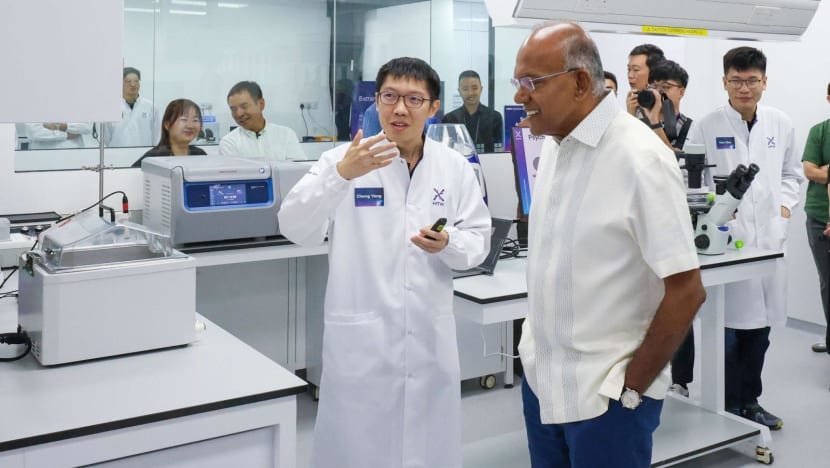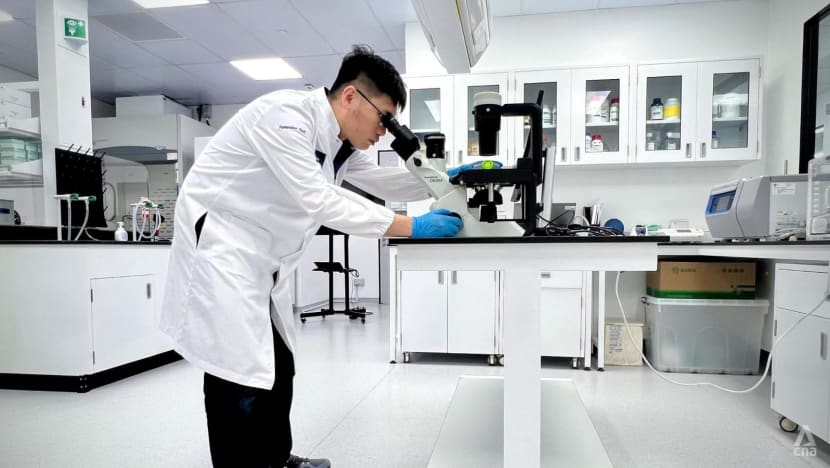To aid drug enforcement, Singapore opens first forensic lab to examine, detect new psychoactive substances
The forensic lab under the Home Team Science and Technology Agency has developed a wearable device that can detect traces of drugs in a person's perspiration.

Senior forensic scientist Ng Cheng Yang (front, left) giving Home Affairs and Law Minister K Shanmugam a tour of HTX's pharmacology laboratory on Apr 14, 2025. (Photo: HTX)

This audio is generated by an AI tool.
SINGAPORE: Singapore's first forensic laboratory for investigating new psychoactive substances was launched on Monday (Apr 14), amid an exponential increase in the supply of such substances worldwide.
Known as the Forensic Innovation and Research for Strategic Transformation (FIRST) lab, the facility under the Home Team Science and Technology Agency (HTX) leverages scientific techniques to evaluate the psychoactive potential of the suspected substances, the statutory board said in a media release.
New psychoactive substances mimic the effects of controlled drugs such as cannabis and heroin and have been modified to evade drug enforcement.
Last year, more than 1,200 new psychoactive substances were reported to the United Nations Office on Drugs and Crime by 142 countries and territories.
There are now 566 such substances on the market, of which 44 are newly identified, a 2024 report on the drug situation in Singapore by the Central Narcotics Bureau (CNB) stated.
Speaking at the opening of the lab, Minister for Law and Home Affairs K Shanmugam said that the facility was a "very important, strategic capability".
It works backwards to identify the possible chemicals that are coming out and the different chemical combinations that can give users a kick or a high, he added.
"We are working ahead of time, and legislation has been amended to deal with new psychoactive substances," Mr Shanmugam said, referring to amendments passed to Singapore’s drug laws in March 2023 to combat new psychoactive substances more effectively.
Scientists at FIRST synthesise drugs to get a better idea of the consequences of taking them. "They are doing very quick hair analysis testing. Within 10 minutes, you can identify whether a person has taken drugs," he said.
Dr Ngeow Kao Chin, a senior forensic scientist, told CNA that in this way, CNB may then take enforcement action based on the psychoactive potential of suspected substances rather than relying solely on the drugs' chemical structures.
On the challenges that the team faced, Dr Ngeow who is from HTX's forensics centre of expertise acknowledged that the concept of testing substances for their psychoactive potential or effect was "quite a new thing".
"The capability is very new, so we have to set up many things ourselves … I think that was the main difficulty."

TESTING PERSPIRATION FOR DRUGS
Apart from testing new psychoactive substances, the lab has developed a range of technologies such as a wearable device that can detect traces of drugs in the user's perspiration.
This could be used to monitor people under drug rehabilitation programmes for timelier intervention, HTX said.
The facility also makes use of artificial intelligence and bioinformatics, which uses computer technology to analyse biological data, to improve its investigation capabilities in areas apart from drugs.
This includes the use of neural networks – machine-learning models that make decisions in a manner similar to the human brain – to predict the sex of people whose fingerprints are found at a crime scene.
This allows investigators to narrow the pool of suspects at a scene and could potentially reduce investigation time, the agency said.
The lab is also researching the use of human proteins such as those found in hair to identify people.
"If successful, this innovation can provide investigative leads in cases where standard DNA analysis is unsuccessful," HTX added.

The agency also said that it was pioneering research in airborne human DNA analysis to complement traditional forensic approaches to crime scene investigation.
Other fields in which the lab conducts forensic research include post-bomb blast investigations and attribution of forensic evidence with greater accuracy to people of interest, through techniques that analyse biomolecules such as proteins.
HTX's director of the forensics centre of expertise Lim Chin Chin said that the agency is committed to harnessing science and technology to support frontline work and stay ahead of evolving threats.
"Ultimately, our mission is to reshape Home Team operations – embedding forensics as a force multiplier across all operations – from prevention to response," she said.
















